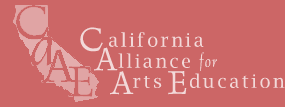| |
Theater production at Pioneer school district]
|
|
PRESS RELEASE 2005: QEA Report
For Immediate Release
11.16.2006
Contact:
Ronnie Lippin
Jeanne O'Keefe
The Lippin Group/L.A.
323.965.1990
[email protected]
[email protected]
Politicians, Arts and Education Leaders Enthusiastically Endorse
Briefing Paper
Pasadena, CA - November 16, 2005 - The California Alliance for Arts Education
(CAAE) introduced today a crucial "Quality, Equity, and Access"
report on the state of visual and performing arts education in California's
K-12 schools. The briefing paper presents a comprehensive analysis of
the status of arts education and the need for stronger policies to support
arts instruction in all schools in California.
*"Quality, Equity, and Access" has already attracted endorsements
from:
- Assemblywoman Jackie Goldberg
- Senator Jack Scott
- Brenda J. Davis President, California State PTA
- William Habermehl, Orange County Superintendent of Schools
- John Hughes, President, Rhythm & Hues
- Muriel Johnson, Director, California Arts Council
- Sheila Jordan, Superintendent, Alameda County Schools
- Scott P. Plotkin, Executive Director, California School Board Association
- Dr. Larry Reider, President of the California County Superintendents
Association
- Darline Robles, Ph.D., Superintendent, Los Angeles County Office
of Education
- Mark Slavkin, Vice President for Education, Los Angeles Music Center
Education Division
- Glen Thomas, Ed.D., Executive Director, CA County Superintendents
Educational Services Association
- Harold M. Williams, President Emeritus, The J. Paul Getty Trust
Other notable politicians, organizations and educators have
expressed interest in supporting this effort and are in the process of
reviewing the briefing paper.
The well-documented and researched information in the "Quality, Equity
and Access" briefing paper reports that despite support from the
public, various policies and occasional positive developments, decreasing
state education funding and new accountability measures have paved the
way for a dangerous trend of narrowed arts education in schools K-12.
Numerous studies confirm the benefits of arts education on learning. Nonetheless,
the reduction or elimination of arts curriculum continues in schools throughout
California.
Of particular concern is the discrepant program cuts affecting lower socioeconomic
students, mostly black and Latino, who historically have less access to
music and arts programs. This is despite strong documentation that shows
arts have measurable positive impact on students in high-poverty and urban
settings. (Quality, Equity, and Access Report, page 2).
Battling the second-rate image arts courses have in some schools, which
relegate them to 'enrichment' or extra-curriculum status, the "Quality,
Equity and Access" report emphasizes that students with high levels
of arts participation outperform their peers with little or no arts. Furthermore,
arts experiences enhance critical thinking abilities and outcomes, while
engagement in the arts nurtures the development of cognitive, social and
personal competencies. (Quality, Equity, and Access Report, page 6).
Although arts education is required for California students in grades
one though twelve, most laws are not uniformly implemented across all
school districts in the state. The "Quality, Equity and Access"
report recommends qualified instructors who can teach from updated, standard-based
curriculum during the school day, while receiving adequate funding at
both the district and state levels.
Additionally, CAAE emphasizes the importance of accountability, with a
school accountability report card indicating the status of arts participation
and curriculum policies, as well as appropriate and detailed student assessments
in every pre K-12 standards-based arts course, and a statewide arts assessment
administered at the 4th and 8th grade levels.
“Learning in the visual and performing arts has undeniable benefits
for all students, says Laurie Schell, Executive Director of CAAE. “It’s
a win-win for students, teachers, educators, parents and communities.
CAAE’s intent is to shine a light on arts education and its essential
role in a complete education for each of California’s 6 million
students.”
Eighteen states now require the equivalent of one or more full years in
the visual and performing arts for all students as a stand-alone graduation
requirement (not shared with another subject area). **California is not
among them. California Alliance for Arts Education's goal is to ensure
quality arts education in California’s public schools and guide
the policies that guarantee those courses be available to all students.
About CAAE
California Alliance for Arts Education promotes, supports and advocates
for visual and performing arts education for preschools through post-secondary
students in California schools. For 30 years, CAAE has advocated for arts
education, cultivating alliances and providing a communications network
for the 1.2 million arts education stakeholders statewide. To learn more,
visit www.artsed411.org. *A list of direct
quotes from each supporter can also be accessed at CAAE’s website.
**2004-05 State Arts Education Policy Database compiled by the Arts Education
Partnership.
 [updated 4.14.06]
[top of page] [updated 4.14.06]
[top of page]
|



